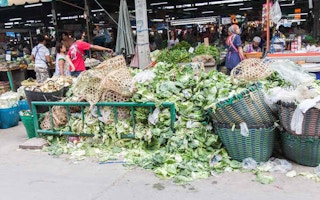Governments, businesses and citizens’ groups are joining forces to try to put some beef into efforts to cut food loss and waste in a world facing growing hunger.
Almost a third of all food produced globally − enough to feed everyone in the world for two months − is lost or wasted, the UN’s Food and Agriculture Organisation (FAO) says. And not only does this cost US$940 billion annually, it also causes around 8 per cent of global greenhouse gas emissions and consumes about a quarter of all the water used by agriculture.
The new coalition, launched at the World Economic Forum meeting that ended in the Swiss resort of Davos yesterday, is called Champions 12.3 − a nod to the UN’s Sustainable Development Goals (SDGs).
Production and supply
Target 3 of the SDGs’ 12th goal commits the world to specific action: “By 2030, halve per capita global food waste at the retail and consumer levels and reduce food losses along production and supply chains, including post-harvest losses.”
The coalition is committed to “inspiring ambition, mobilising action, and accelerating progress toward achieving” the target. It says reducing food loss and waste can be a triple win: saving money for farmers, companies, and households; feeding more people; and alleviating pressure on climate, water, and land resources.
The Champions include CEOs of major companies, government ministers, and executives of research and intergovernmental institutions, foundations, farmer organisations and civil society groups. They will work “to create political, business and social momentum” to reduce food loss and waste around the world.
They plan to inspire others to act chiefly through “leading by example”, and some of them at least have a record of progress on the problem.
The FAO puts the global impact of lost and wasted food in context, saying that producing the total amount requires a cropland area the size of China.
Also launched at the Davos meeting is the Rockefeller Foundation’s YieldWise Initiative, which has the more focused aim of reducing post-harvest losses for African farmers.
It says the amount of the world’s available food that either spoils or gets thrown away before it reaches a plate is about 33 per cent total production, and is enough to feed everyone in the world for two months.
“With 1.2 billion people food-insecure or undernourished, millions of vulnerable smallholder farmers losing profits they can’t spare, and a population expected to increase by 2 billion by 2050, we cannot afford to allow these losses to continue.”
Buyers for yields
But YieldWise says solutions already exist, ranging from wider adoption of technologies that keep food fresh longer to models of private sector engagement that ensure farmers have steady buyers for their yields.
It plans to focus initially on fruit, vegetables, and staple crops in Kenya, Nigeria, and Tanzania, where it says up to half of all food grown is lost.
But it does not plan to restrict its work to Africa. It says: “In industrialised nations, this loss occurs not between harvest and markets, but at the retail and consumer level.
“Put simply, consumers don’t want to buy bruised peaches and misshapen tomatoes, even if the nutrition content, taste and quality of this food is the same as one that ‘looks right’. This bias accounts for 1.5 trillion pounds of annual waste in the US, and costs economies approximately $680 billion in annual losses.”
And when it comes to the cost to the climate of food produced but not eaten, YieldWise puts it at 3.3 billion gigatonnes of CO2 and 66 trillion gallons of water annually.








